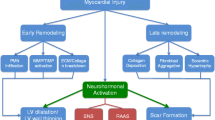Abstract
Deleterious left ventricular remodeling routinely occurs after myocardial infarction (MI) and novel strategies to attenuate this phenomenon may prove valuable. Here, we describe the potential role of left ventricular (LV) peri-infarct pacing (delivered via biventricular pacemakers) to reduce post-MI remodeling. Regional wall stress in the infarcted area is predictive of remodeling and therefore represents a potential therapeutic target. Using an intrinsic property of pacing to reduce stress and work at the pacing site, there are animal data to suggest that long-term peri-infarct pacing can have a salutary effect on cardiac structure after MI. This concept was tested in a pilot human study, suggesting attenuation of ventricular dilation in post-MI patients treated with LV pacing compared with control. To further characterize this concept, a 110-patient, multicenter, randomized Prevention of Myocardial Enlargement and Dilatation post-Myocardial Infarction Study (MENDMI) has completed enrollment. Inclusion criteria included anterior MI, QRS < 120 ms, ejection fraction ≤ 35%, CPK > 2,000, and wall motion abnormalities in at least five of 16 segments. MENDMI will help to determine whether chronic application of peri-infarct pacing provides structural and clinical benefits and will help in the design of further investigations to modify postinfarction ventricular remodeling.


Similar content being viewed by others
References
American_Heart_Association (2006). Heart disease and stroke statistics—2006 update. Dallas: American Heart Association.
Giannuzzi, P., Temporelli, P. L., Bosimini, E., et al. (2001). Heterogeneity of left ventricular remodeling after acute myocardial infarction: results of the Gruppo Italiano per lo Studio della Sopravvivenza nell'Infarto Miocardico-3 Echo Substudy. American Heart Journal, 141(1), 131–138, Jan.
Bolognese, L., Neskovic, A. N., Parodi, G., et al. (2002). Left ventricular remodeling after primary coronary angioplasty: Patterns of left ventricular dilation and long-term prognostic implications. Circulation, 106(18), 2351–2357, Oct 29.
Lavine, S. J. (2003). Prediction of heart failure post myocardial infarction: comparison of ejection fraction, transmitral filling parameters, and the index of myocardial performance. Echocardiography, 20(8), 691–701, Nov.
Udelson, J. E., Patten, R. D., & Konstam, M. A. (2003). New concepts in post-infarction ventricular remodeling. Review in Cardiovascular Medicine, 4(Suppl 3), S3–S12.
Coletta, C., Sestili, A., Seccareccia, F., et al. (2003). Influence of contractile reserve and inducible ischaemia on left ventricular remodelling after acute myocardial infarction. Heart, 89(10), 1138–1143, Oct.
Pfeffer, M. A., Braunwald, E., Moye, L. A., et al. (1992). Effect of captopril on mortality and morbidity in patients with left ventricular dysfunction after myocardial infarction. Results of the survival and ventricular enlargement trial. The SAVE Investigators. New England Journal of Medicine, 327(10), 669–677, Sep 3.
Pfeffer, M. A., McMurray, J. J., Velazquez, E. J., et al. (2003). Valsartan, captopril, or both in myocardial infarction complicated by heart failure, left ventricular dysfunction, or both. New England Journal of Medicine, 349(20), 1893–1906, Nov 13.
Pitt, B., Remme, W., Zannad, F., et al. (2003). Eplerenone, a selective aldosterone blocker, in patients with left ventricular dysfunction after myocardial infarction. New England Journal of Medicine, 348(14), 1309–1321, Apr 3.
Doughty, R. N., Whalley, G. A., Walsh, H. A., et al. (2004). Effects of carvedilol on left ventricular remodeling after acute myocardial infarction: The CAPRICORN Echo Substudy. Circulation, 109(2), 201–206, Jan 20.
Gaudron, P., Eilles, C., Kugler, I., et al. (1993). Progressive left ventricular dysfunction and remodeling after myocardial infarction. Potential mechanisms and early predictors. Circulation, 87(3), 755–763, Mar.
de Kam, P. J., Nicolosi, G. L., Voors, A. A., et al. (2002). Prediction of 6 months left ventricular dilatation after myocardial infarction in relation to cardiac morbidity and mortality. Application of a new dilatation model to GISSI-3 data. European Heart Journal, 23(7), 536–542, Apr.
Warren, S. E., Royal, H. D., Markis, J. E., et al. (1988). Time course of left ventricular dilation after myocardial infarction: Influence of infarct-related artery and success of coronary thrombolysis. Journal of the American College of Cardiology, 11(1), 12–19, Jan.
Solomon, S. D., Glynn, R. J., Greaves, S., et al. (2001). Recovery of ventricular function after myocardial infarction in the reperfusion era: the healing and early afterload reducing therapy study. Annals of Internal Medicine, 134(6), 451–458, Mar 20.
Moustakidis, P., Maniar, H. S., Cupps, B. P., et al. (2002). Altered left ventricular geometry changes the border zone temporal distribution of stress in an experimental model of left ventricular aneurysm: A finite element model study. Circulation, 106(12 Suppl 1), I168–I175, Sep 24.
Solomon, S. D., Aikawa, Y., Martini, M. S., et al. (1998). Assessment of regional left ventricular wall stress after myocardial infarction by echocardiography-based structural analysis. Journal of the American Society of Echocardiography, 11(10), 938–947, Oct.
Aikawa, Y., Rohde, L., Plehn, J., et al. (2001). Regional wall stress predicts ventricular remodeling after anteroseptal myocardial infarction in the Healing and Early Afterload Reducing Trial (HEART): an echocardiography-based structural analysis. American Heart Journal, 141(2), 234–242, Feb.
Prinzen, F. W., Hunter, W. C., Wyman, B. T., et al. (1999). Mapping of regional myocardial strain and work during ventricular pacing: experimental study using magnetic resonance imaging tagging. Journal of the American College of Cardiology, 33(6), 1735–1742, May.
Kass, D. A., Chen, C. H., Curry, C., et al. (1999). Improved left ventricular mechanics from acute VDD pacing in patients with dilated cardiomyopathy and ventricular conduction delay. Circulation, 99(12), 1567–1573, Mar 30.
Shuros, A. C., Salo, R. W., Florea, V. G., et al. (2007). Ventricular preexcitation modulates strain and attenuates cardiac remodeling in a swine model of myocardial infarction. Circulation, 116(10), 1162–1169, Sep 4.
Chung, E. S., Menon, S. G., Weiss, R., et al. (2007). Feasibility of biventricular pacing in patients with recent myocardial infarction: impact on ventricular remodeling. Congestive Heart Failure, 13(1), 9–15, Jan–Feb.
Author information
Authors and Affiliations
Corresponding author
Rights and permissions
About this article
Cite this article
Chung, E.S., Mazur, W., Menon, S.G. et al. Peri-infarct Pacing with CRT in the Early Postinfarct Phase to Attenuate Long-term Remodeling. J. of Cardiovasc. Trans. Res. 2, 126–129 (2009). https://doi.org/10.1007/s12265-008-9059-4
Received:
Accepted:
Published:
Issue Date:
DOI: https://doi.org/10.1007/s12265-008-9059-4




